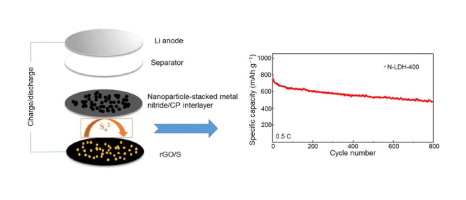Science Bulletin ( IF 18.8 ) Pub Date : 2017-12-20 , DOI: 10.1016/j.scib.2017.12.018 Zhen Li 1 , Zhaoling Ma 1 , Yanyong Wang 1 , Ru Chen 1 , Zhenjun Wu 1 , Shuangyin Wang 2

|
Shuttle effect is one of the most serious disadvantages in lithium-sulfur battery which results in poor cycle performance and hinders the commercialization of Li-S battery. To reduce the dissolution of polysulfides into the electrolyte and prolong the cycling stability, nanoparticle-stacked metal nitride derived from layered double hydroxides (LDHs) as an interlayer was inserted between sulfur cathode and separator to confine polysulfides by physical and chemical interactions. Meanwhile, the surface of metal nitride will form an oxide passivation layer. The passivation layer possesses hydrophilic metal-O group and provides a polar surface for strong binding with polysulfide. What’s more, the nanoparticles-stacked structure could immerge and retain electrolyte well, which could enhance the ability of promoting the electron exchange rate. The sulfur electrode with nanoparticle-stacked metal nitride interlayer has an excellent cycle performance owing to the interactions between metal nitride and polysulfides. The battery delivered an initial capacity of 764.6 mAh g−1 and still possesses a capacity of 477.5 mAh g−1 with the retention of 62.4% after 800 cycles.
中文翻译:

LDHs衍生的纳米颗粒堆叠金属氮化物作为长寿命锂硫电池的中间层
穿梭效应是锂硫电池最严重的缺点之一,导致循环性能差,阻碍了锂硫电池的商业化。为了减少多硫化物在电解质中的溶解并延长循环稳定性,将层状双氢氧化物(LDHs)衍生的纳米颗粒堆叠金属氮化物作为中间层插入硫正极和隔膜之间,通过物理和化学相互作用限制多硫化物。同时,金属氮化物表面会形成一层氧化物钝化层。钝化层具有亲水性金属-O基团,并提供极性表面以与多硫化物强结合。更重要的是,纳米颗粒堆叠结构可以很好地浸没和保留电解质,这可以增强促进电子交换速率的能力。由于金属氮化物和多硫化物之间的相互作用,具有纳米颗粒堆叠的金属氮化物中间层的硫电极具有优异的循环性能。电池初始容量为 764.6 mAh g-1并且在800次循环后仍具有477.5 mAh g -1的容量,保留率为62.4%。











































 京公网安备 11010802027423号
京公网安备 11010802027423号